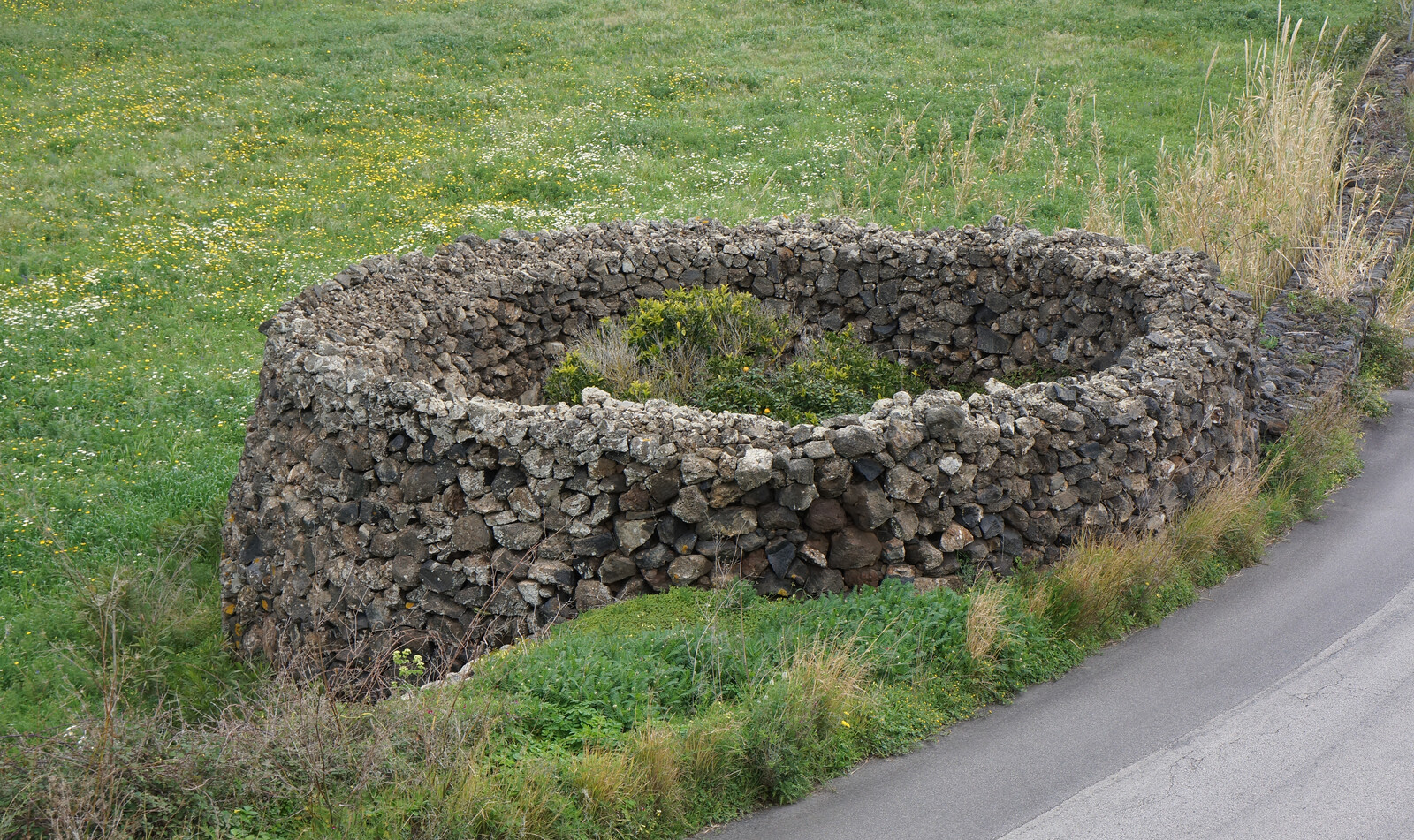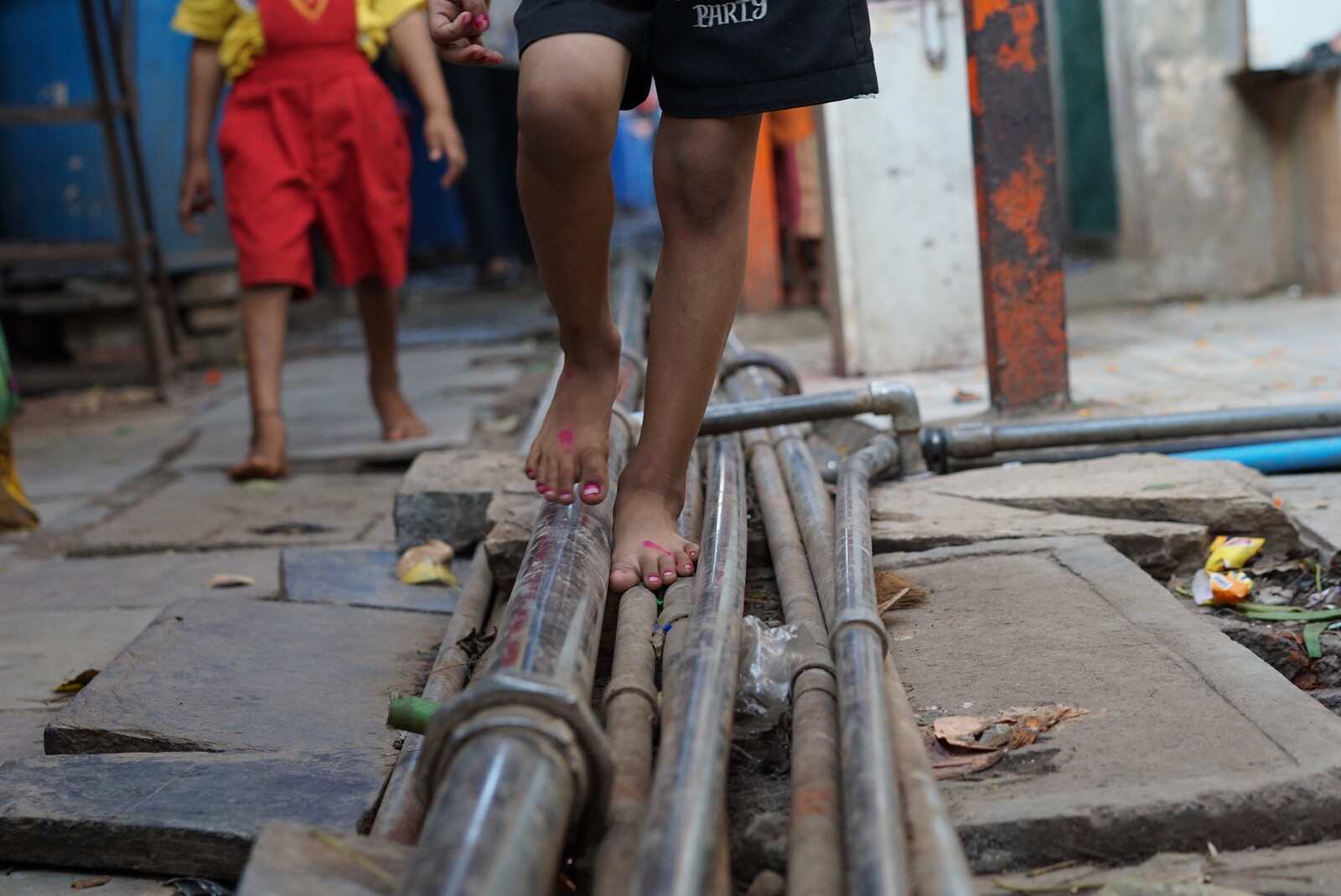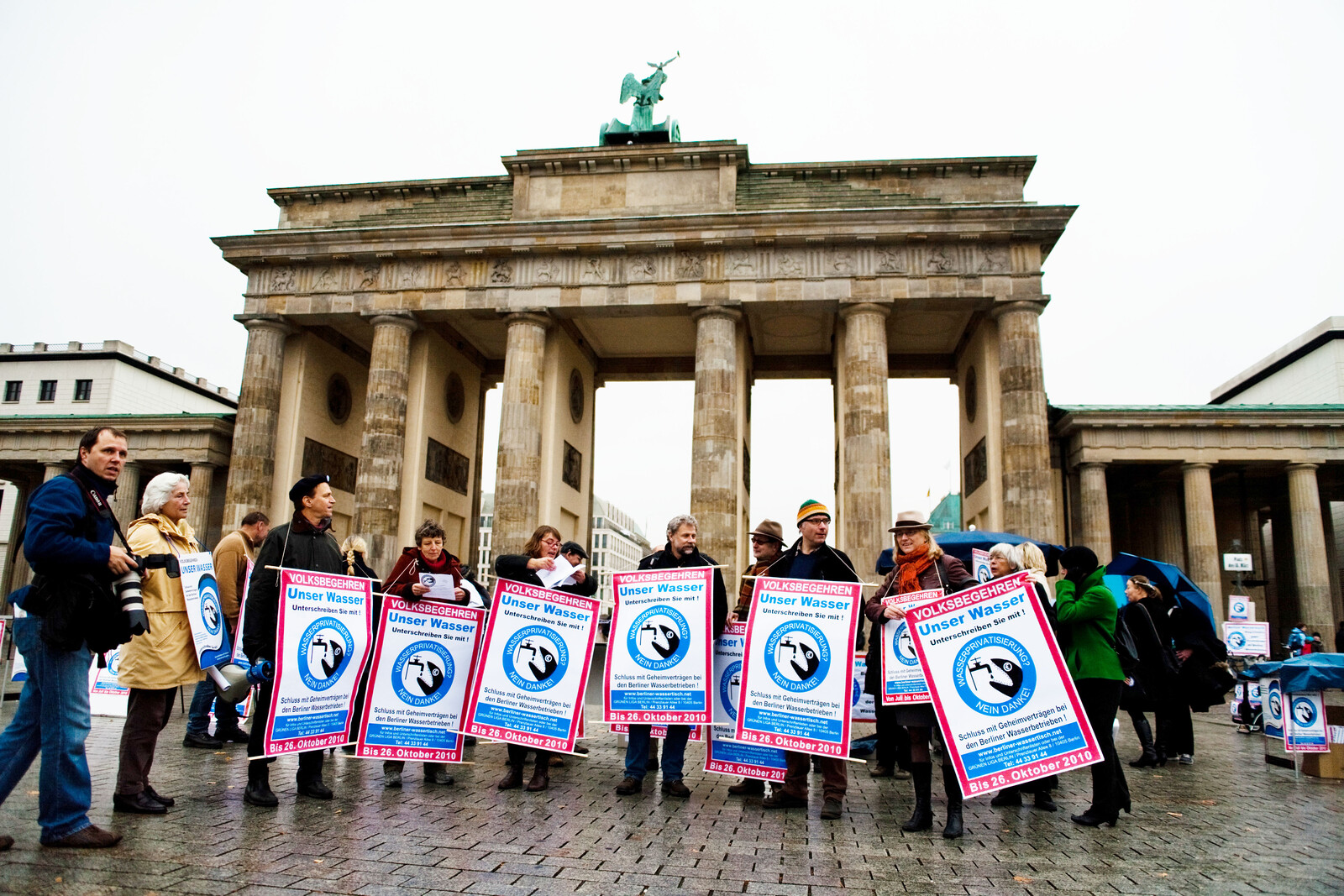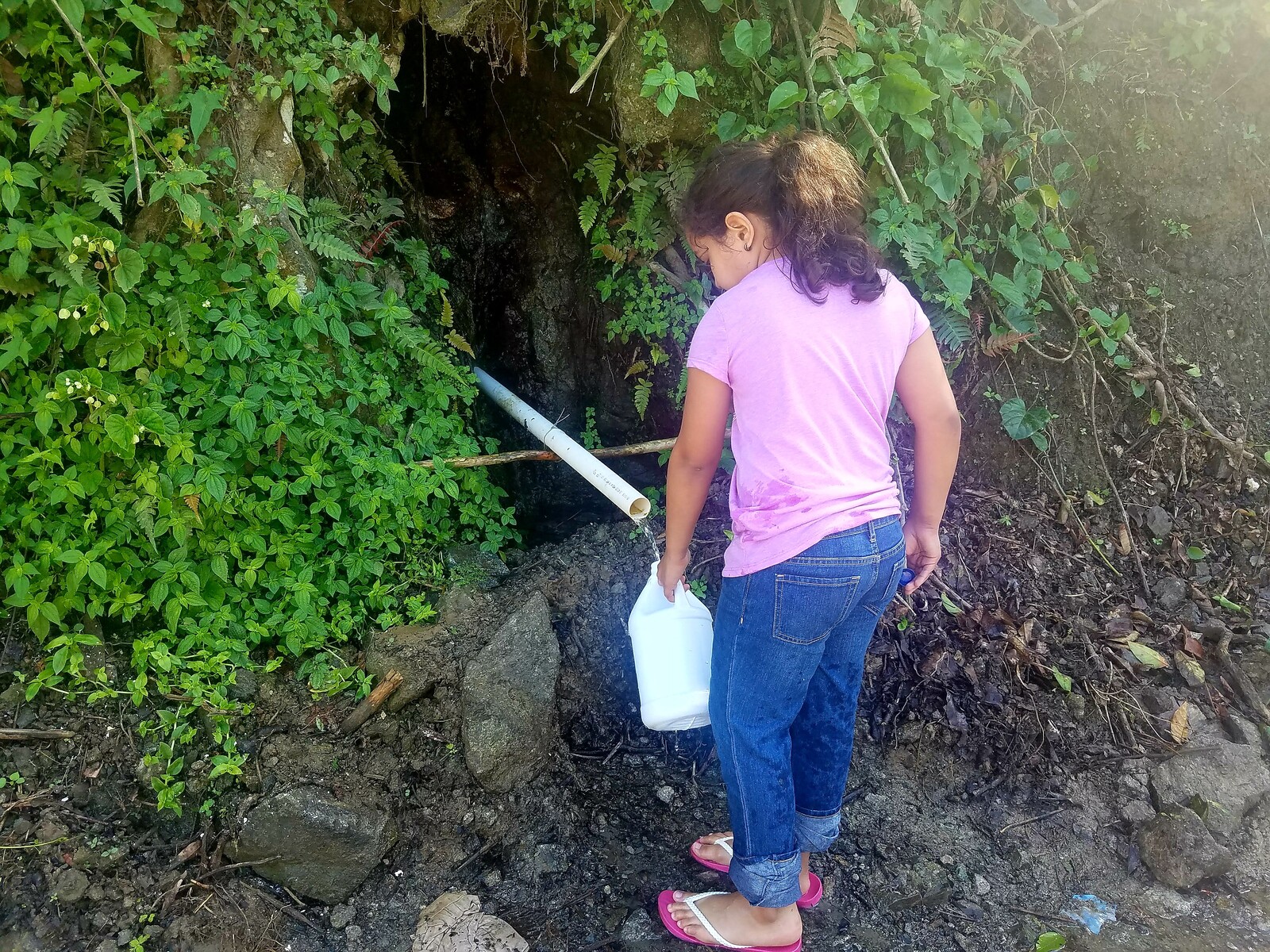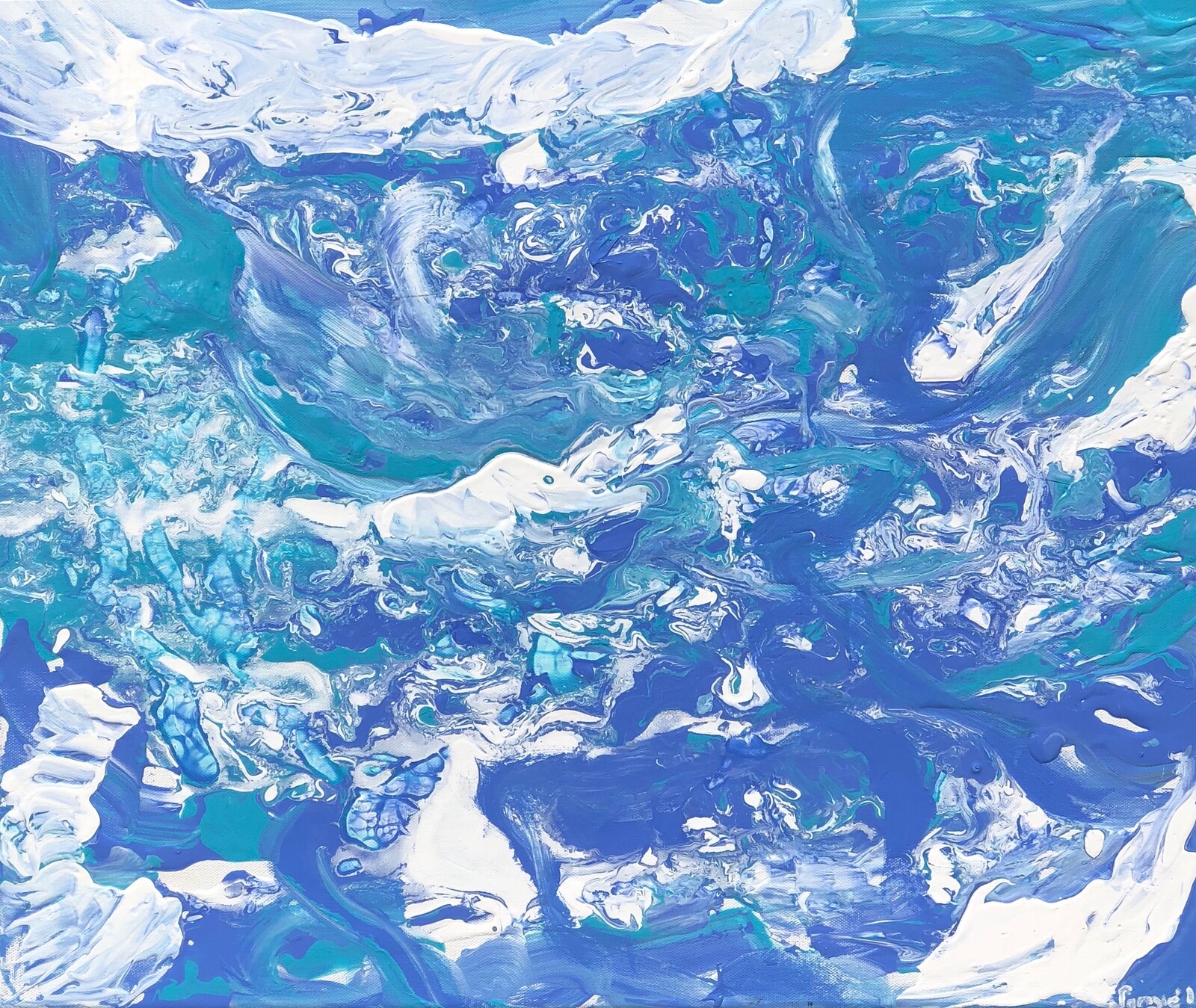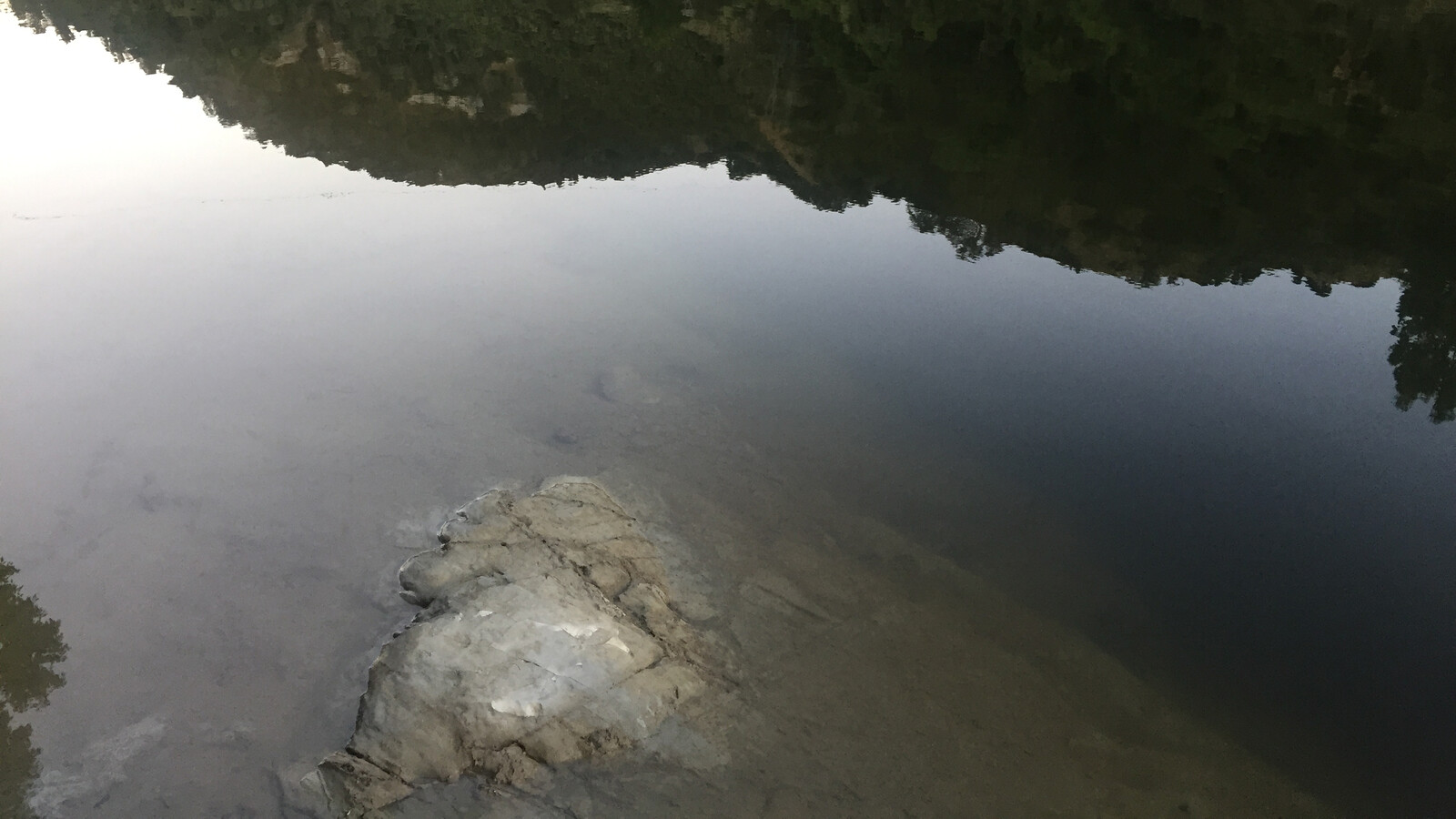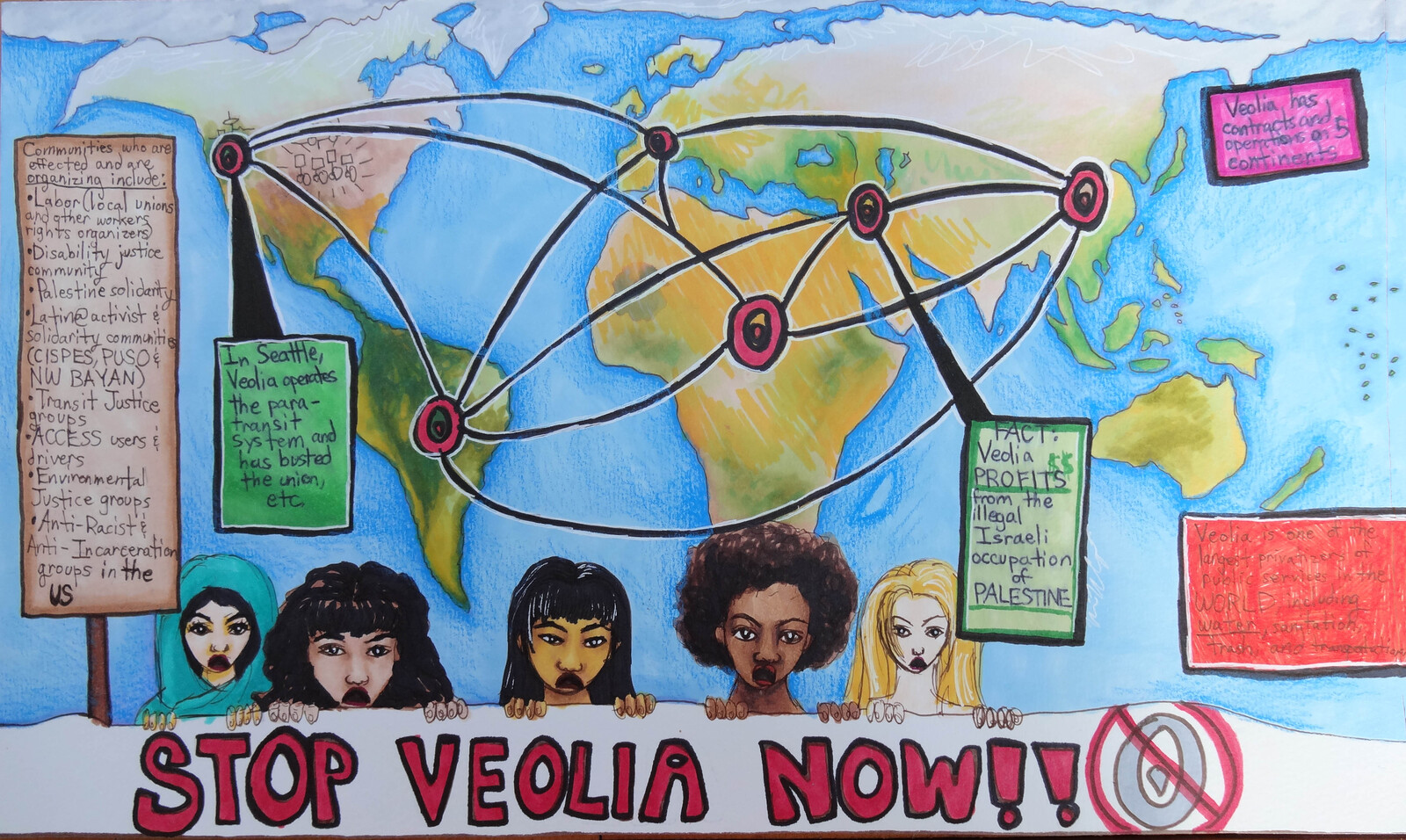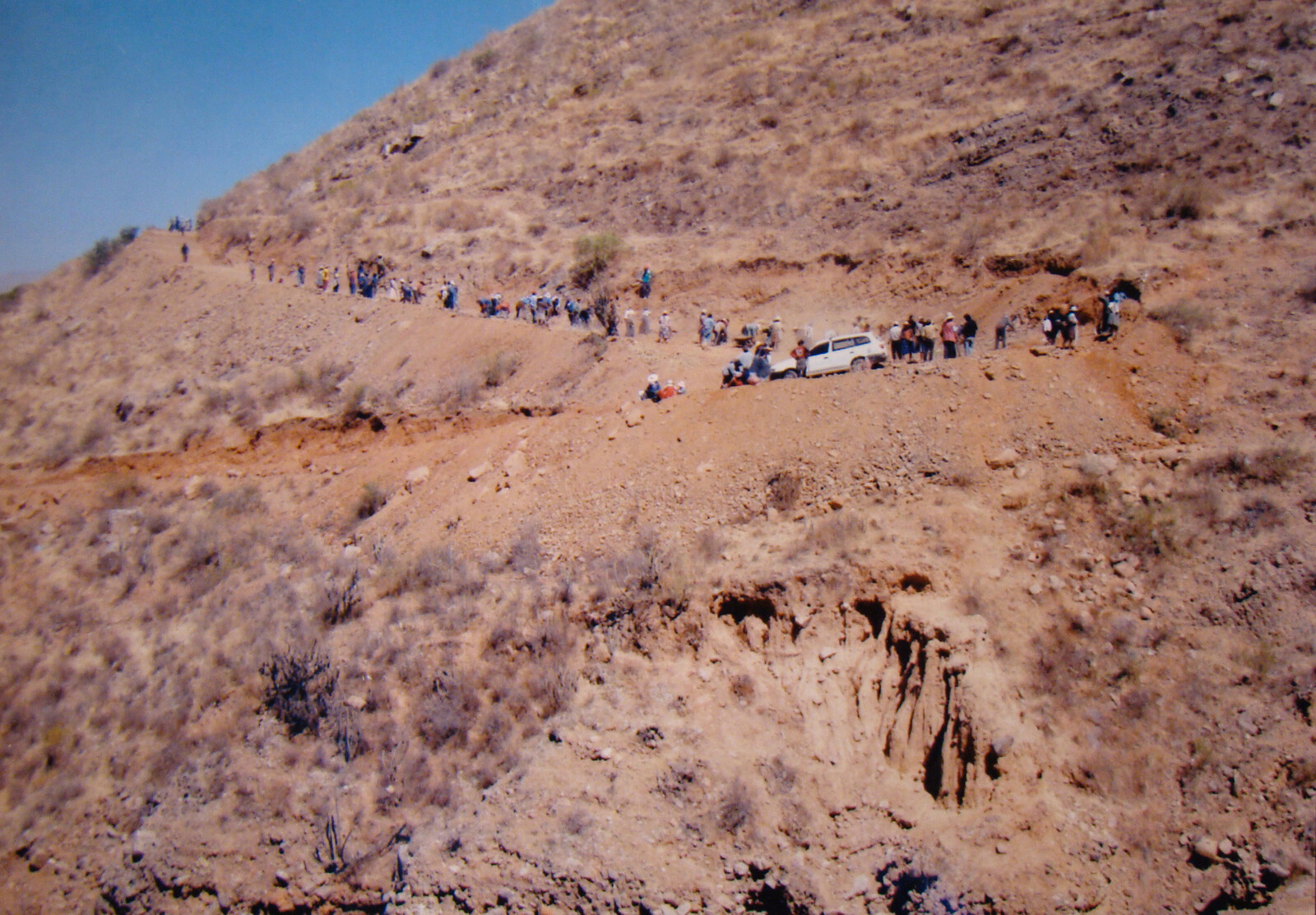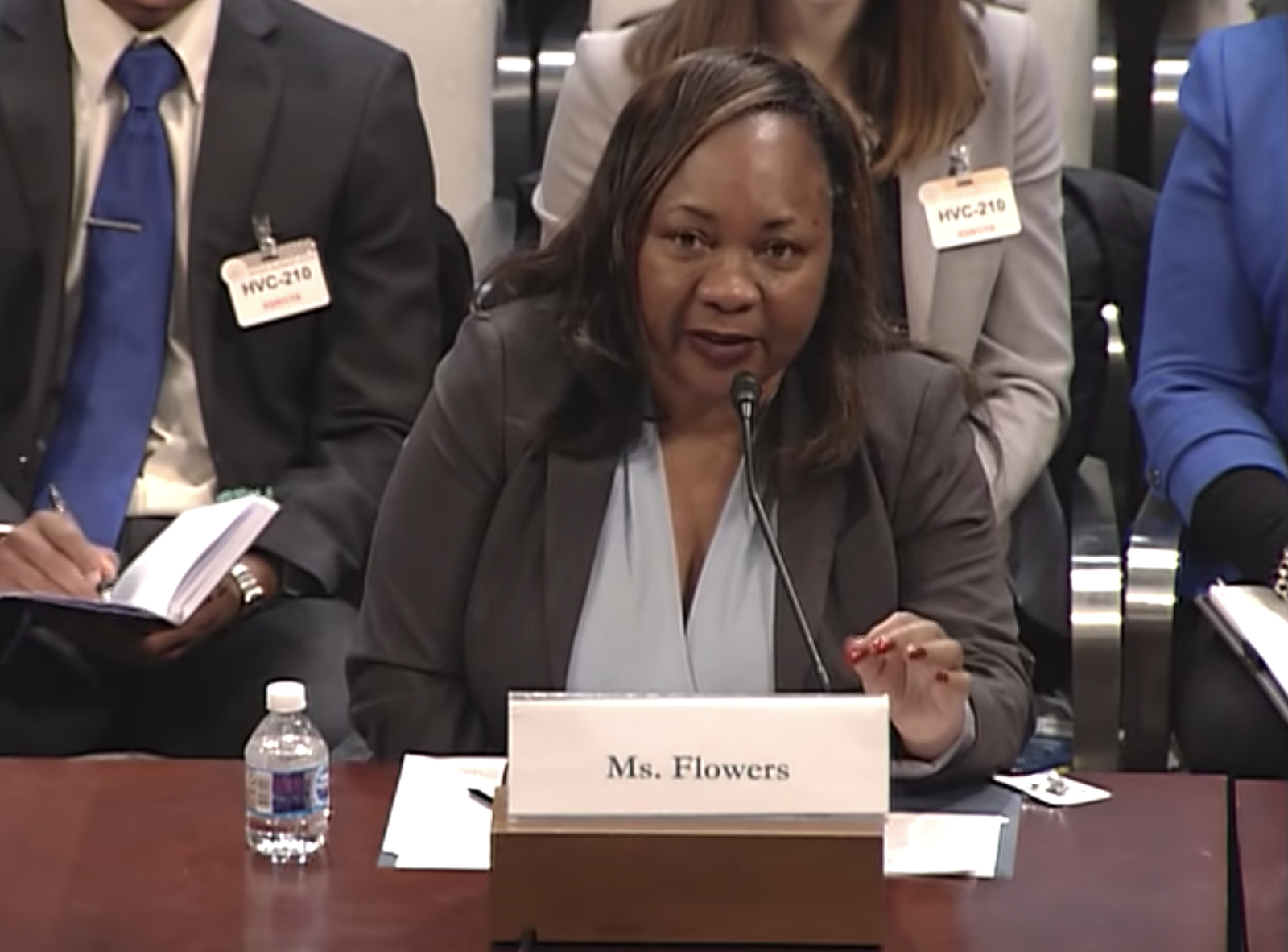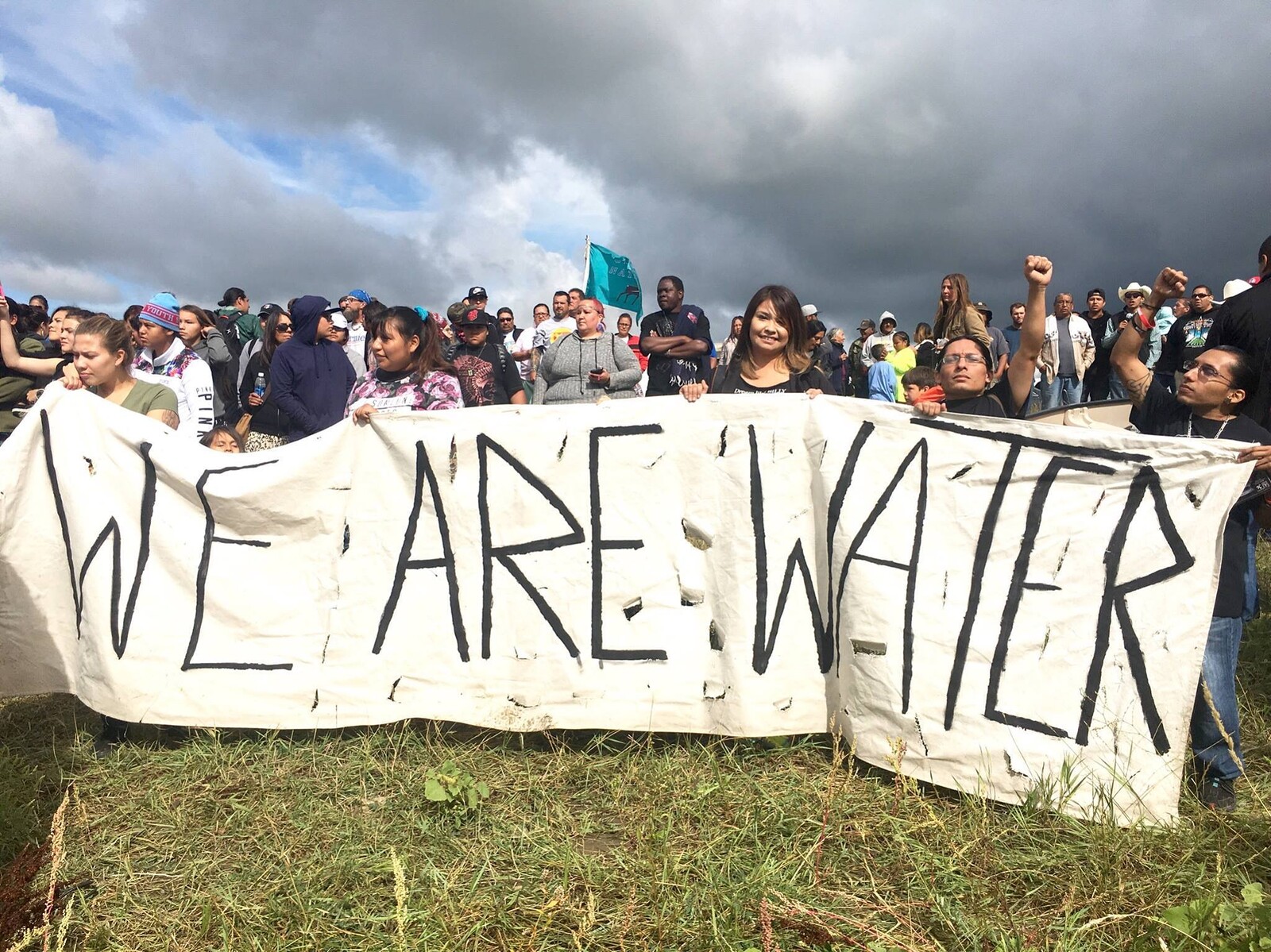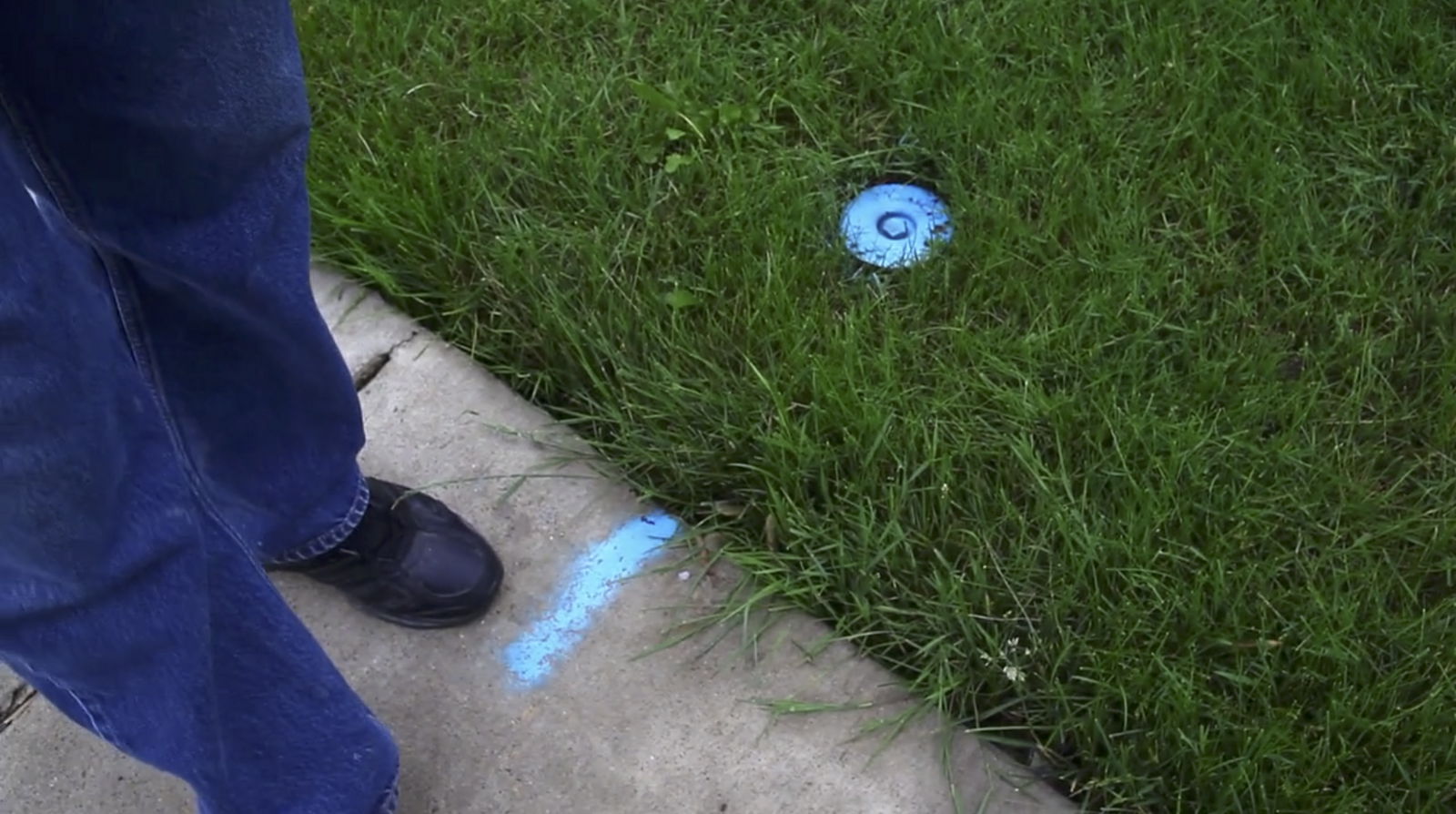Not only the sun. Man-made tunnels, cisterns, and terraces to channel and retain water in Sicily have turned the largest Mediterranean island into one of the most fertile agricultural engines in Europe today.1 Despite dating back more than 1,000 years, the Arab roots of the architecture of irrigation and dry-farming in Sicily are still present in the names of some of the infrastructures populating its agrarian landscapes.2 Over centuries, the struggle to cultivate edible produce in a drought-prone territory with seasonal torrential rains—swept by the dry sirocco winds from the Sahara—has resulted in the development of complex water technologies to squeeze every drop from the soil, providing crops with the humidity they require to thrive. Dry irrigation techniques were developed to turn Sicily into a hydraulic society with booming exports of citrus fruits. Hence, water dependence for the growing agricultural sector allowed for the control of space and people by organized crime structures, and allows for the exploration of other soil practices that could be used to combat both drought and political extortion, and ultimately, to emancipate trees from water.
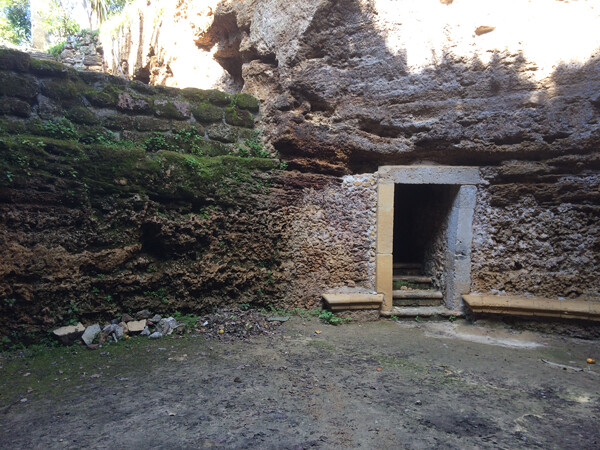

Excavated Camera dello Scirocco, Volpe Astuta, Micciulla, Palermo. Photo: Cooking Sections, 2018.
To Water Without Water
Hydraulic and political systems have developed hand in hand in Sicily, as local agricultural methods are not only used to protect slopes from erosion and replenish aquifers, but also to construct social organizations.3 Christian feudal societies in Southern Europe that depended on grain—a storable staple that produces surplus value—tended to have more hierarchical state-dominant structures than neighboring Muslim territories. The latter introduced irrigation methods and cultivated considerably more perishable fruits and vegetables, which limited the amount of taxes that could be collected from them.4 Grains allowed populations to concentrate and settle, providing a necessary condition for state formation. Most legumes, fruit, and vegetables, on the contrary, are crops that can be picked only as long as they grow, complicating the job of the tax collector.5
In the Sicilian rural arid landscape, ingenious adaptations to the topography of the terrain follow microclimatic principles that have allowed orchards and gardens to flourish in the absence of precipitation. Developed to bypass the need for humans to water their crops, this millenary infrastructure to water without water relies on sculpting the landscape in the vicinity of valleys and depressions to make the most of air humidity and let crops get more access to other underground sources. Referent examples from the pre-Arab period in Sicily include the Giardino Della Kolymbethra in Agrigento, which was set inside a sheltered gorge shaped in the fifth century BC, during the Greek settlement period,6 and the Hypogean Gardens of Favignana, which were planted in disused limestone quarries and took advantage of the microclimatic protection of the open air cavities below ground.7 Likewise, in urban contexts, the drinking water supply was used to condition air for temperature comfort, profoundly shaping urban fabrics and contributing to the development of innovative architectural typologies. Paradigmatic examples in Palermo include the Castello della Zisa and Castello di Maredolce, both built around the eleventh and twelfth centuries.8 A large pool faces Zisa, connecting exterior and interior spaces through water flowing in cascades. Together with a system of vent ducts running from upper levels to the lower vestibule, the water feature provides humidity and constant air flow through the entire building. Maredolce (meaning “sweet sea”) sits by an artificial lake to drop the palace’s air temperature in the summer. The lake also has an island in the middle planted with citrus groves.
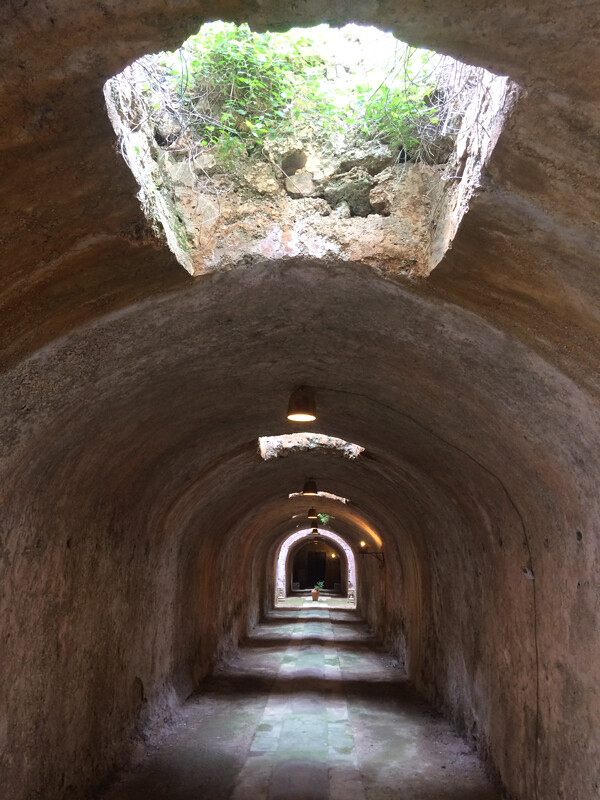

Corridor-shaped Camere dello Scirocco under Villa Naselli, Palermo. Photo: Cooking Sections, 2018.
Palermo itself lies on top of an intricate network of qanāt tunnels, dug over the past thousand years to channel fresh water and air from the mountains. Measuring one-meter wide and two-meters high, and running an average of one to two kilometers long, they extend underneath nearly the entire city and penetrate the basements of Arab-Norman, Renaissance, and Baroque palazzi. In winter, this system of Persian origin directs water runoff from the hills outside the city toward the urban center. Since a qanāt relies on passively tapping the water table by gravity, it does not upset the natural water balance—as opposed to pumped withdrawal, which can lead to aquifer depletion—and represents one of the most ecological water recovery systems available for arid regions.9 Making use of similar knowledge and techniques as deployed in Kolymbethra, Favignana, Zisa, and Maredolce, these tunnels also serve as microclimates for humans. In summer, when water flow decreases, air temperatures significantly drop and the tunnels’ wider sections become cool leisure spaces. The success of the qanāt system is associated with stone-carved spaces known as “sirocco rooms” or Camere dello Scirocco, named after the arid wind that can raise air temperature drastically, but that they succeed to ameliorate.10 These chambers of wind refrigerate the atmosphere of the aristocratic homes above them, functioning as air-conditioned rooms by transforming the liquid water from the mountain into a cool breeze.
Other techniques for creating microclimates and watering without water can be found in Pantelleria, a volcanic island enclave between the Tunisian and Sicilian coasts, where 300 circular dry-stone walls enclose single-tree gardens. Without that confinement for humidity and wind protection, the precious citrus trees inside would otherwise never fruit, as the island lacks springs, rivers, or any other freshwater source.11 Known in the local dialect as Jardinu Pantescu, these circular (but also sometimes rectangular, pentagonal, or trapezoid) structures measure seven to twelve meters in diameter, around three-and-a-half meters in height, and approximately one-meter in thickness (two-meters at the base).12 The Jardinu Pantescu is a man-made microclimate: its thick stone perimeter absorbs humidity from the air and, due to the temperature difference between the outer and inner sides of the wall, condenses water droplets.13 Helped by this dew-harvesting technique, the temperature gradient aids to provide moisture for both the tree and the soil inside.
Jardini Panteschi are often located near a dammuso, a domestically-scaled structure typical of Pantelleria that also makes the most out of its scarce rains. Consisting of a thick stonewall housing typology, dammusi are comprised of one to three rectangular rooms, each of which has a domed roof that collects water through a drain into an underground tank. There are 692 such cisterns documented in Pantelleria, most of which are bottle-shaped.14 Paradoxically, the lack of any other water source on the island correlates with a much more egalitarian society than in other surrounding territories, where extortion around the access to irrigation could be exercised more intensively.15 Historically, each farmer in Pantelleria has patches of land in three or four different locations with different harvest dates, which enhances food security in the event of a pest in one of them, while providing an efficient form of labor organization and mutual sharing of work, like the collective de-stoning of their fields and the repurposing of the removed stones.16 As Sicilian agronomists Giuseppe Barbera and Antonio Motisi remark, these aspects have also led to the formation of a biocultural diversity uncommonly high for an area the size of Pantelleria.17 Indeed, different citrus fruits have been carefully selected for Jardini Panteschi for centuries in order to allow for different heirloom varieties to fruit in every season, providing a continuous supply of vitamin C throughout the year. Among them, the citrone lunare (moon lemon) stands out for its capacity to blossom every twenty-eight days. Other crops have also been tamed to survive in local microclimates, like legumes protected from sirocco winds by bent cactus leaves, and olive trees trimmed to dwarf size, measuring one-meter high with a cantilevering eight- to ten-meter-wide canopy.
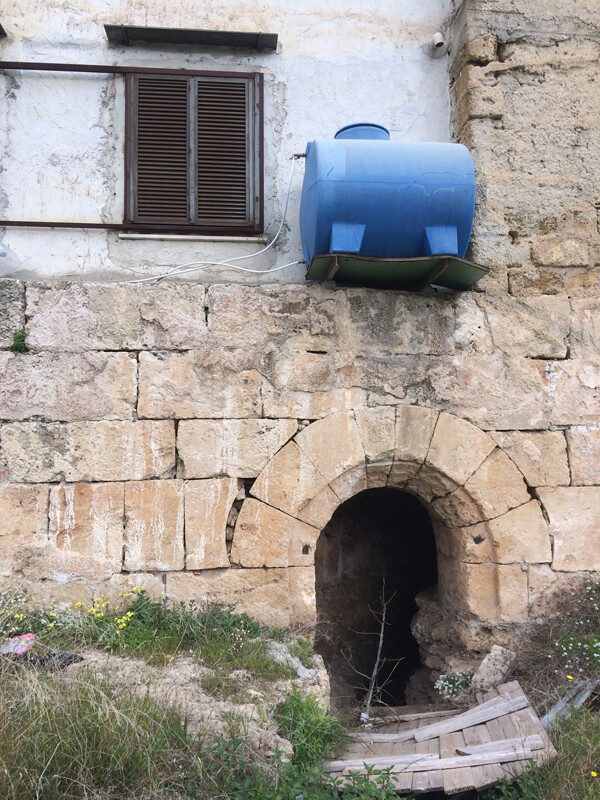

Qanāt under Palermo feeding into the lake of Maredolce. Note the informal water tank attached to the dwelling above that bypasses the city’s public infrastructure. Photo: Cooking Sections, 2018.
Fractured Hydro-Logics and the Nature of Mafia
Landscapes are not only built environments shaped to secure harvests; they are also territories subject to political corruption. Water dependence has allowed power structures to profiteer from the productivity of the Sicilian landscape over centuries.18 The Sicilian Mafia’s emergence throughout the mid to late nineteenth century is directly connected to water control and the intensive cultivation of citrus fruits. Scottish surgeon James Lind’s scientific proof of lemons’ effective use in treating scurvy, a property known empirically by sailors for centuries, resulted in an increased demand for lemons in the nineteenth century. Given Sicily’s already dominant position in the international market for citrus, this resulted in a large flow of revenues into citrus-producing towns.19 Turbulence during the concurrent formation of the Italian state—exacerbated by a growing social gap between the profit-making elite and impoverished farmers, a weak rule of law, and a low level of interpersonal trust—made lemon producers a suitable target for predation.20
Hiring Mafia affiliates for private protection and mediation between retailers and exporters became common practice. Accounts of riots in Palermo demanding general access to water date back to 1849, when farmers from the countryside alongside demonstrators in the city protested together against the unequal distribution of water and the emergence of organized structures which profited from what was formerly a common resource.21 A December 1841 law stated that compensation should be granted for common property rights that had been lost, and affirmed that villagers had usufruct rights to the available water supplies. But it was unclear how these rights could be enjoyed, so landowners contended that the abolition of common property rights also put an end to public rights over water.22 By the end of the nineteenth century, private and public rights over water springs in Sicily were still unclear and thus subject to unregulated private discretion,23 resulting in the motto “meglio avere un amico che un diritto,” or that it is better to have a friend in the system than a right.24
As tensions around water escalated with the development of intensive citrus grove irrigation, especially around Palermo and Catania, Mafia murders began to occur; the first case was documented in Monreale in 1874 and was reportedly committed over the control of a local water source.25 The severe drought of 1893, which caused massive declines in agricultural output and amplified peasant hardships, further emboldened Mafia control across Sicily.26 It was not until World War II that the Mafia started diversifying from citrus into other areas, including the smuggling of cigarettes, arms, drugs, and later, investments in concrete and real estate.
Prolonged interruptions of the supply and rationing of water in Sicily during the severe drought in the summer of 2002 created such social unrest that it brought water dependence back to the center of an extremely polarized public debate that persists today.27 According to Erik Swyngedouw, as inextricable hybrids of natural and social facts, Mafia socionatures link water with the construction of an anti-commons modernity as well as with an attempt to subject the reproductive properties of human and more-than-human communities to economic and infrastructural interests.28 Scholars Marco Armiero, Filippo Gravagno, Giusy Pappalardo, and Alessia Denise Ferrara refer to such landscapes in Sicily as mafio-genic, where a new wave of greenhouse investments in agriculture has led to corruption behind the appropriation of European agricultural subsidies, as well as to the creation of false perceptions of water scarcity and its causes and effects.29 On the one hand, the Mafia gained a crucial role within Sicilian institutions and started appropriating EEC or EU funds for citrus (originally destined for rural investment), which has generated an estimated annual revenue of €16 billion for the Mafia between 2011-2016.30 On the other hand, recent media reporting on water fiascos has taken advantage of the language around emergency and the “great thirst” to perpetuate the vision of the “arid and water-scarce” Sicilian imaginary and ground the need for contracting more and more water infrastructures, despite precipitation being considerably stable over the twentieth century. These terms of aridity and scarcity instrumentalize a deceptive image of the landscape, and further delay water-related investment.
Such institutional fragilities also manifest themselves in the ongoing exploitation of laborers in the booming greenhouse economy in Sicily, where plastic enclosures fill up the plains to produce and export competitively priced fruits and vegetables year-round to high-demand Northern European supermarkets. The same island that once exported thousands of lemons and job-seeking peasants across the Atlantic and the Mediterranean is now heavily dependent on migrant labor from North Africa and Eastern Europe. The availability of cheap and ripe tomatoes year-round in more temperate regions is thus wed to abusive labor practices and human trafficking in the area of Ragusa, for example, where members of the Mafia have a stranglehold on agriculture and force greenhouse laborers to sleep in shanties under conditions of modern slavery.31 Until the end of the 1970s, exploited Sicilian greenhouse workers were mostly Tunisian men without the right to work in Italy. However, since Romania joined the EU in 2007, the employment of its citizens became more convenient in order to avoid the criminal offenses behind the exploitation and facilitation of illegalized migration.32 Nearly 7,500 Romanian women working in Sicilian greenhouses around Ragusa’s “plastic city” were reported as victims not only of labor, but also sexual exploitation.33
As a reaction, several initiatives and organizations promoting slavery-free produce have emerged to support autonomous and cooperative farms that refuse to engage with Mafia structures, like Filiera Sporca or Libera Terra. By raising consumer awareness about the origins and labor conditions of harvests, they support farmers providing legal working conditions and basic human rights. Another active organization is the Cooperative Sociale Proxima in Ragusa, whose members run a series of shelter flats both within and outside of Sicily in which exploited workers can seek refuge, as well as a parallel network of slavery-free greenhouses to empower laborers who escape greenhouse exploitation.
To Water with Stones
Watering without water and control over water have been practiced in tension over centuries in Sicily. The northward expansion of the Sahara desert and global temperature rise, which is expected to reach nearly 5°C under the worst case scenario by 2100, is causing Mediterranean vegetation to replace deciduous forests farther north and displacing humans, especially across Spain and Sicily.34 But what if parts of Sicily could actually liberate themselves from water dependence by learning from historic practices of watering without water? What would it mean today to water without water as a form of emancipation from weather, and thus from water cuts, collective resource appropriations, increasing temperatures, and recurrent droughts? As temperate crops are arriving to formerly frigid zones, the possibility to grow drought-resistant landscapes under water stress could turn Sicily into an experimental site for climate adaptation—and for thinking of the architecture needed for new agricultural imaginaries.35 What is Above is What is Below, a series of installations at Manifesta 12, was one initial attempt.
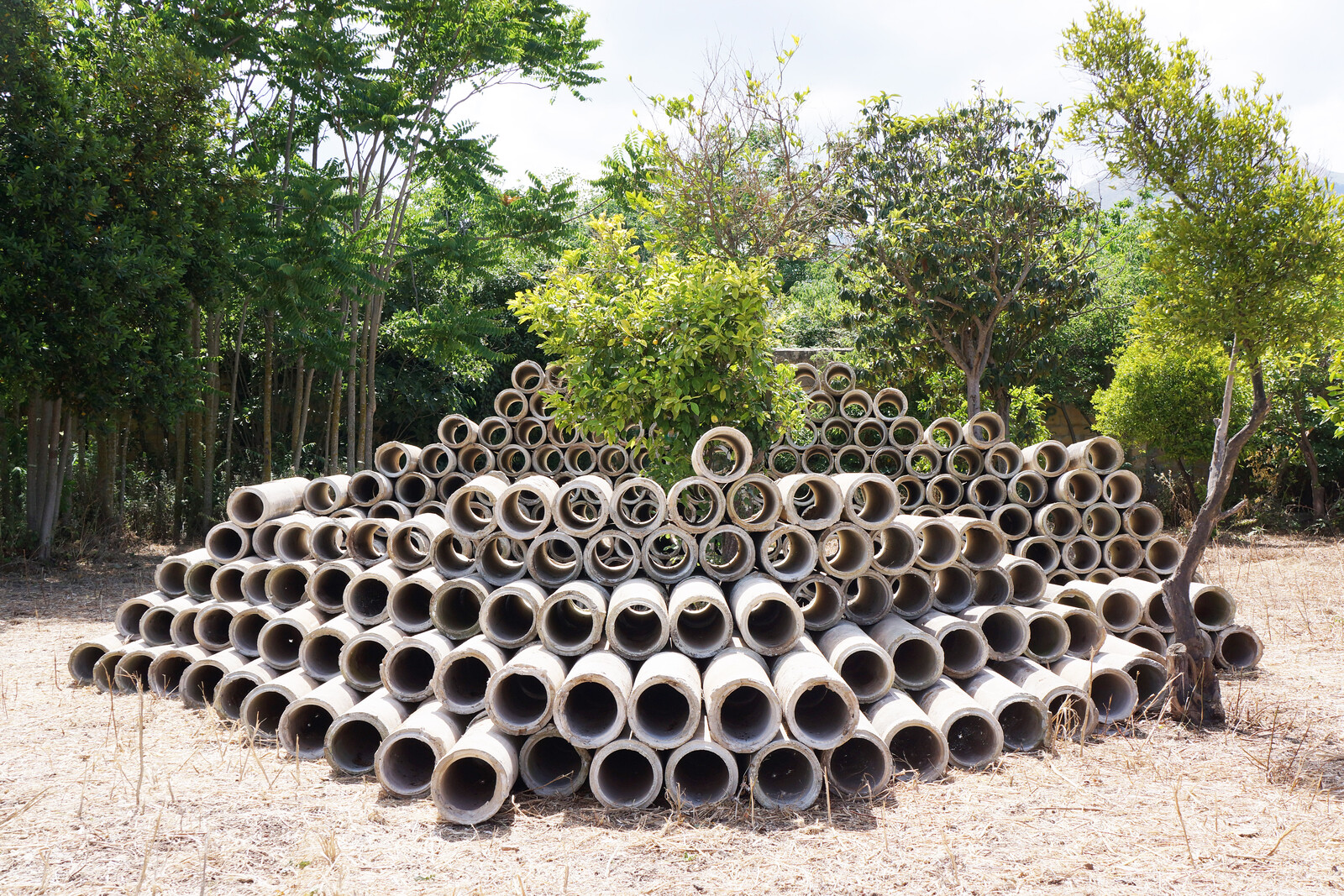
Cooking Sections, What is Above is What is Below, 2018. Installation at Manifesta 12, Volpe Astuta, Altarello, Palermo.
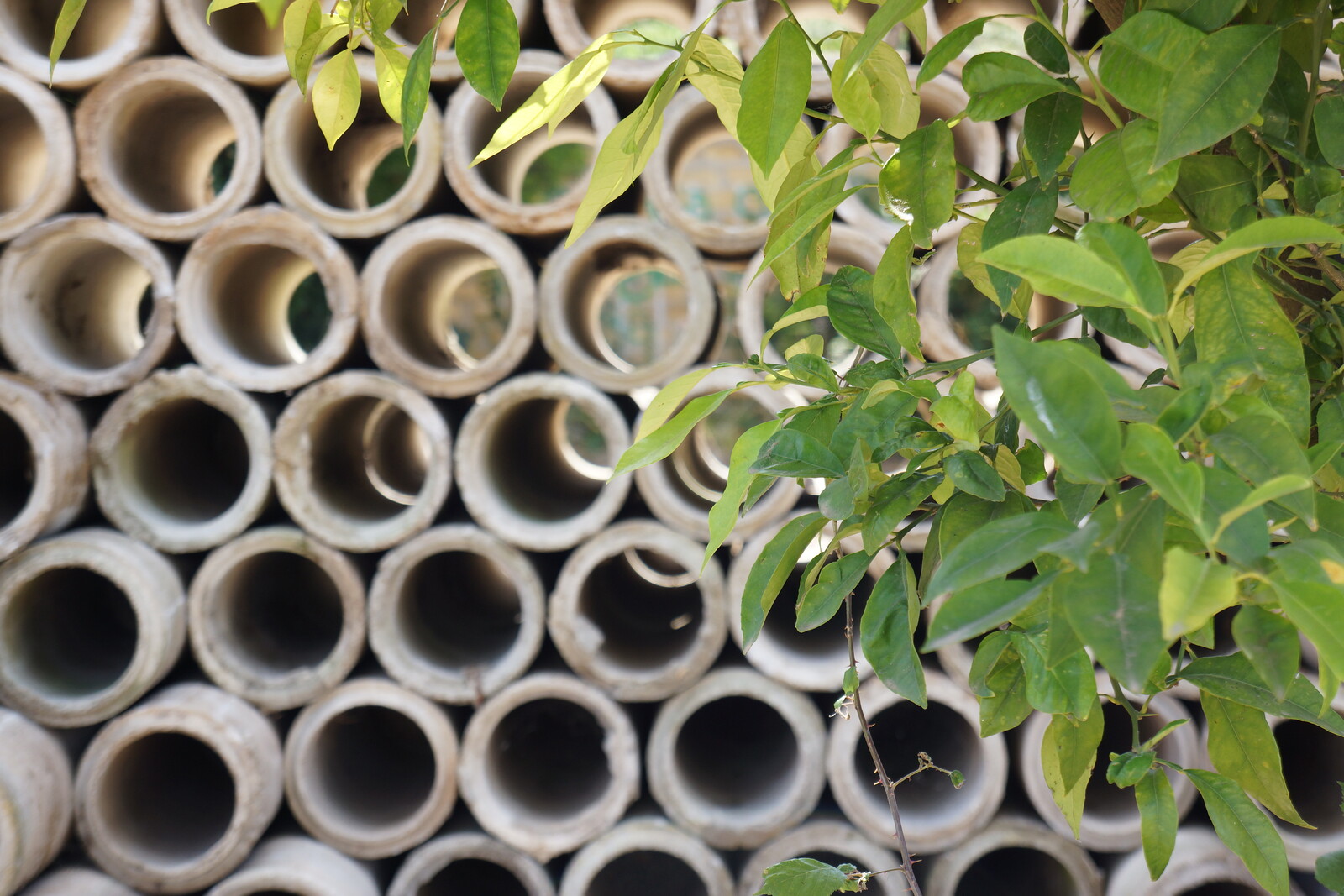
Cooking Sections, What is Above is What is Below, 2018. Installation at Manifesta 12, Volpe Astuta, Altarello, Palermo.

Cooking Sections, What is Above is What is Below, 2018. Installation at Manifesta 12, Volpe Astuta, Altarello, Palermo.
Cooking Sections, What is Above is What is Below, 2018. Installation at Manifesta 12, Volpe Astuta, Altarello, Palermo.
Volpe Astuta in Altarello was an agricultural residence that used to belong to the Sicilian Mafia until it was confiscated more than two decades ago and opened to the public for the common good.36 Located on the remains of a historic citrus landscape at the urban edge of Palermo, the site still conserves an extraordinary mandarin grove. In the heart of the garden, a camera dello scirocco from the fifteenth century connects the medieval qanāt Xibene with the former palace above, which was demolished in the 1980s by a member of the Mafia to build his own modern residence. Repurposing 200 catusi found on site, the traditional tubes used to transport water were organized to direct not liquid water, but humid, fresh air toward an existing mandarin tree. Acting as a shading and humidifying device, the new microclimate around the tree reduces solar radiation and water stress by cooling down the space around it by means of a directed breeze.

Cooking Sections, What is Above is What is Below, 2018. Installation at Manifesta 12, Chiesa di S. Maria dello Spasimo, Palermo.
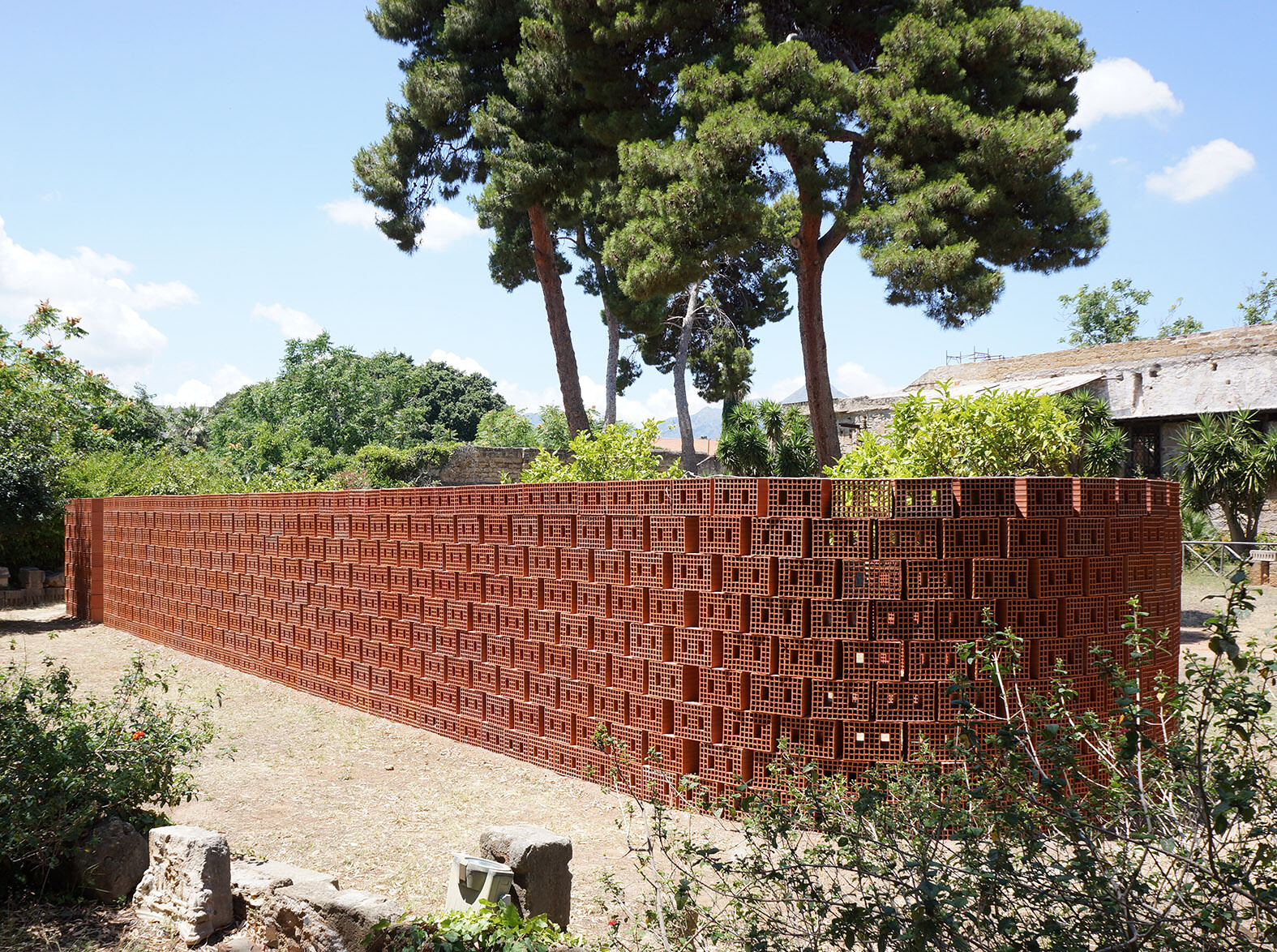
Cooking Sections, What is Above is What is Below, 2018. Installation at Manifesta 12, Chiesa di S. Maria dello Spasimo, Palermo.
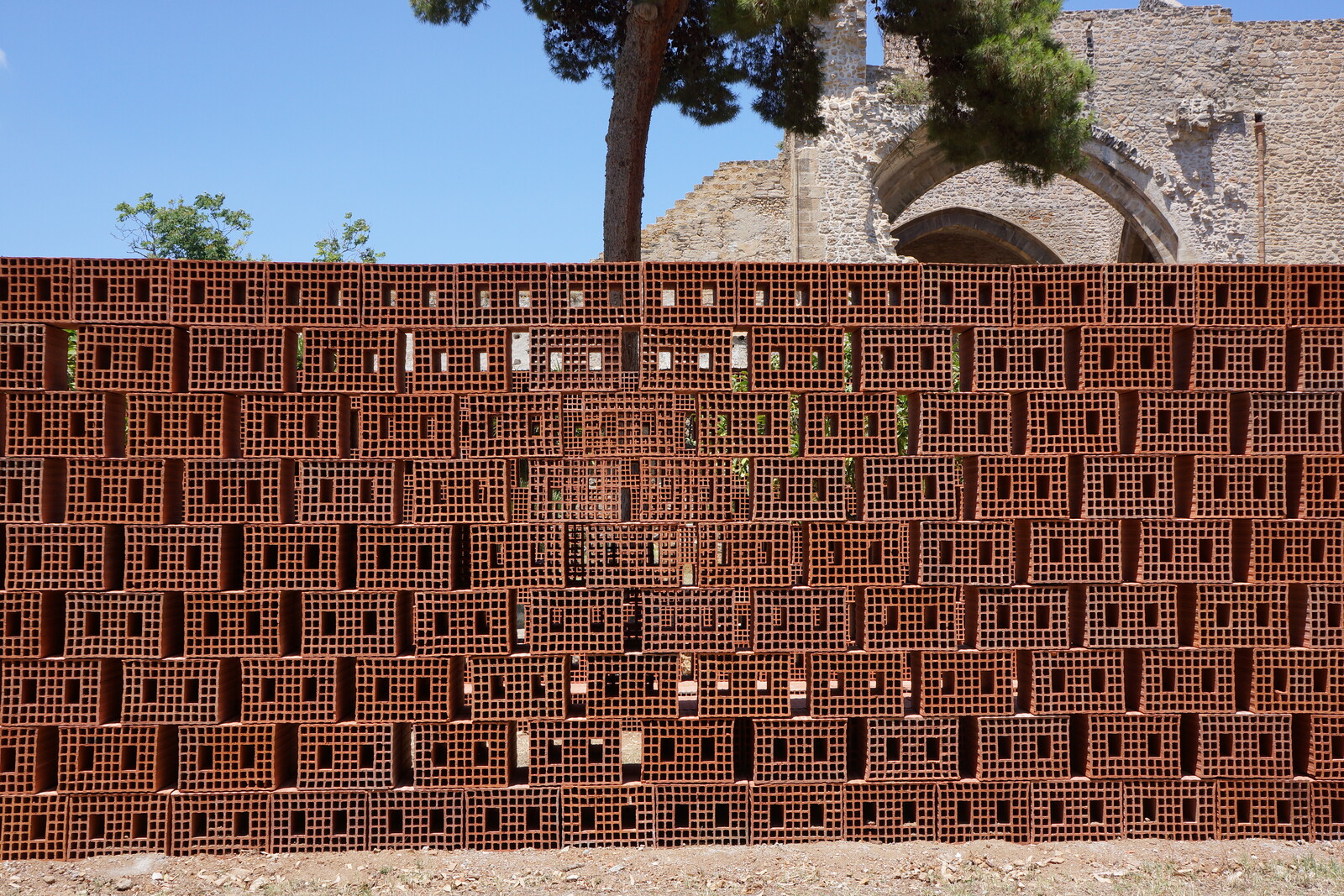
Cooking Sections, What is Above is What is Below, 2018. Installation at Manifesta 12, Chiesa di S. Maria dello Spasimo, Palermo.
Cooking Sections, What is Above is What is Below, 2018. Installation at Manifesta 12, Chiesa di S. Maria dello Spasimo, Palermo.
Within the former city wall and amongst the open-sky ruins of a medieval church sits the garden of the Bastion of the Chiesa di S. Maria dello Spasimo. Arranged around five existing citrus trees, the new microclimate generates a passive cooling effect that helps trees endure harsh environments and allows them to fruit under limited water availability in an arid context. Revisiting the dry stone walls of the Jardinu Pantescu, it uses widely available blocchi laterizzi (hollow clay bricks) rotated on their side to allow air flow. The microclimate functions as a circus-tent-like structure measuring twenty-five-meters long by four-meters wide and accommodates seating in the double thickness of the enclosure.
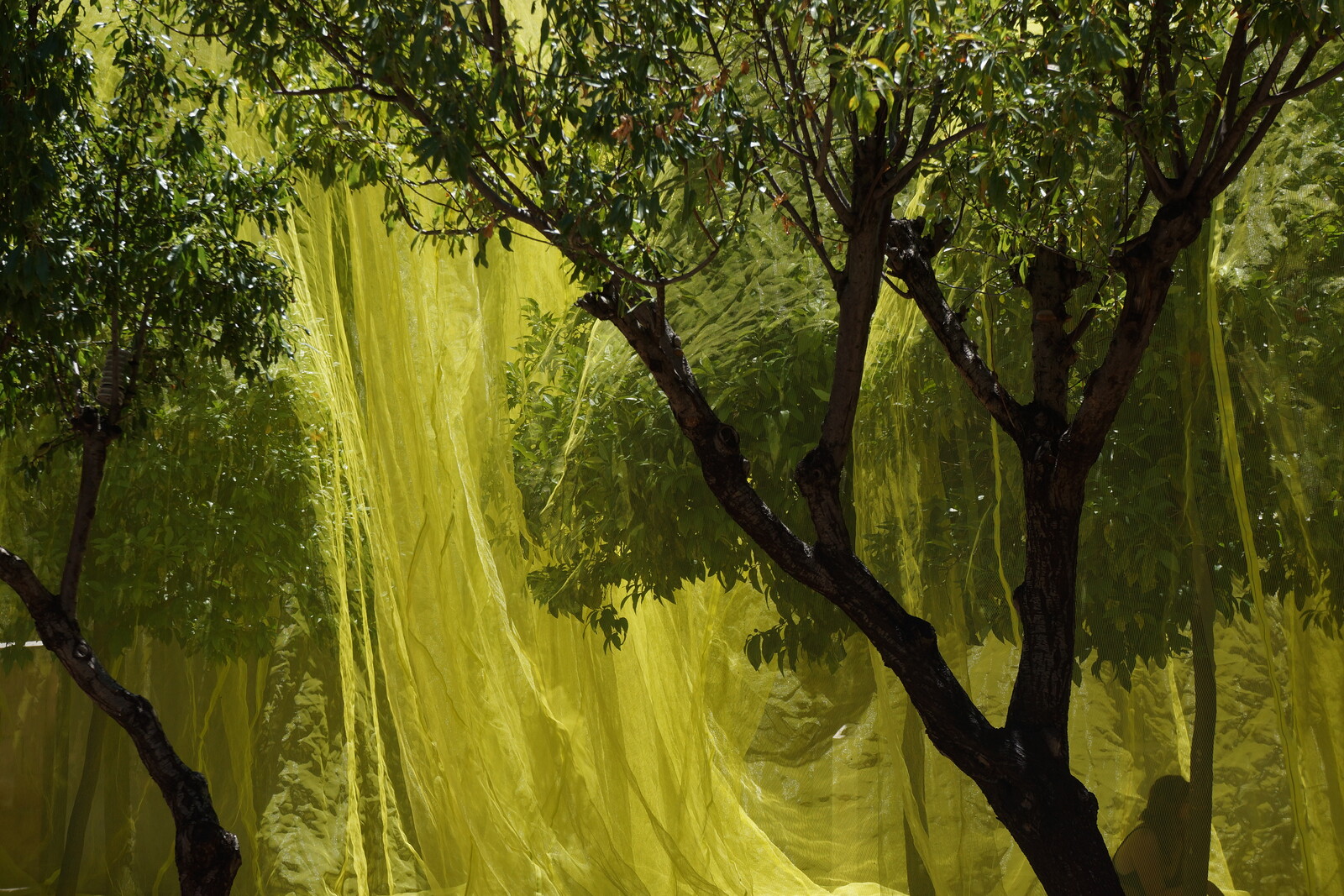
Cooking Sections, What is Above is What is Below, 2018. Installation at Manifesta 12, Giardino dei Giusti, Palermo.
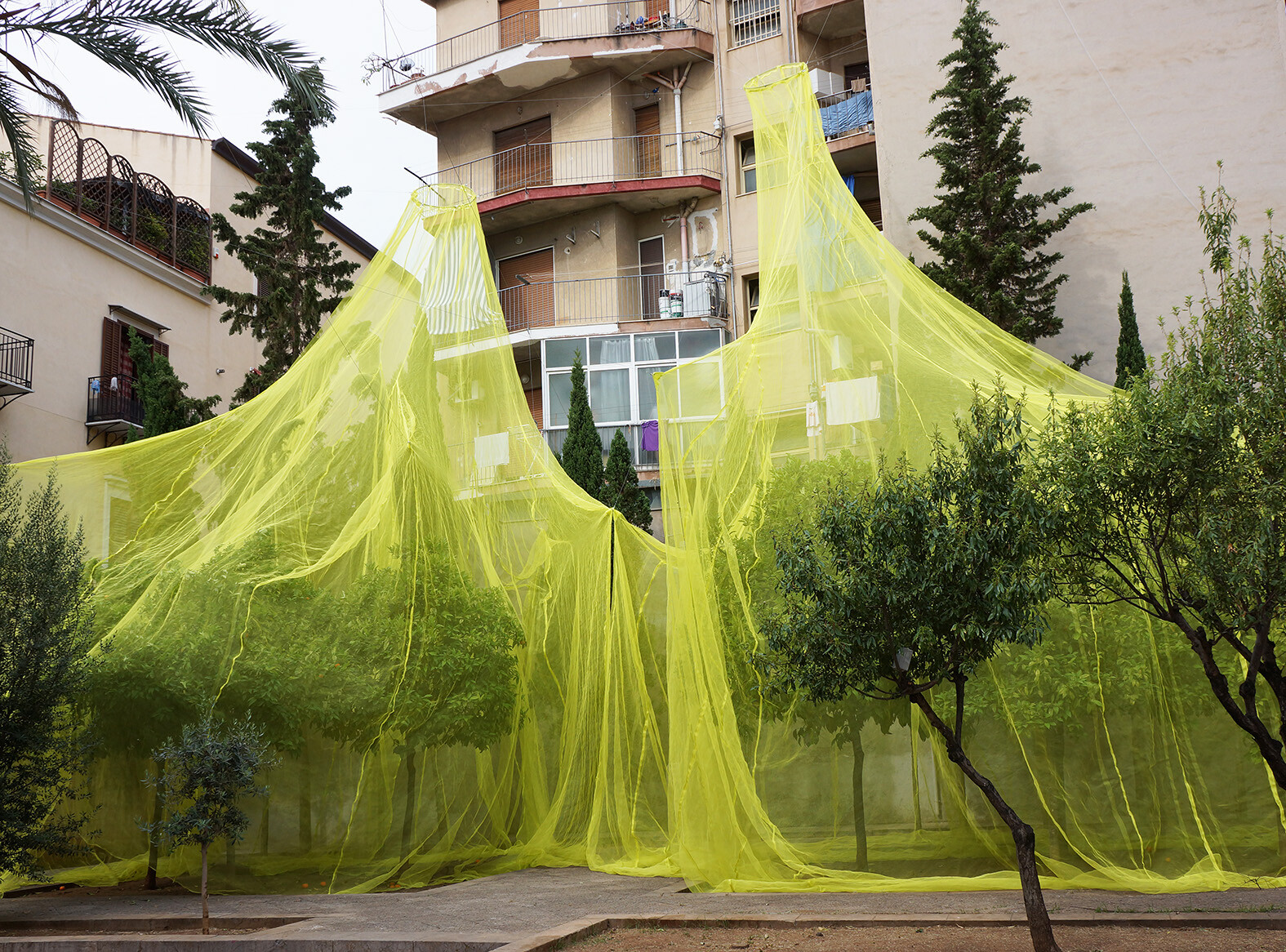
Cooking Sections, What is Above is What is Below, 2018. Installation at Manifesta 12, Giardino dei Giusti, Palermo.
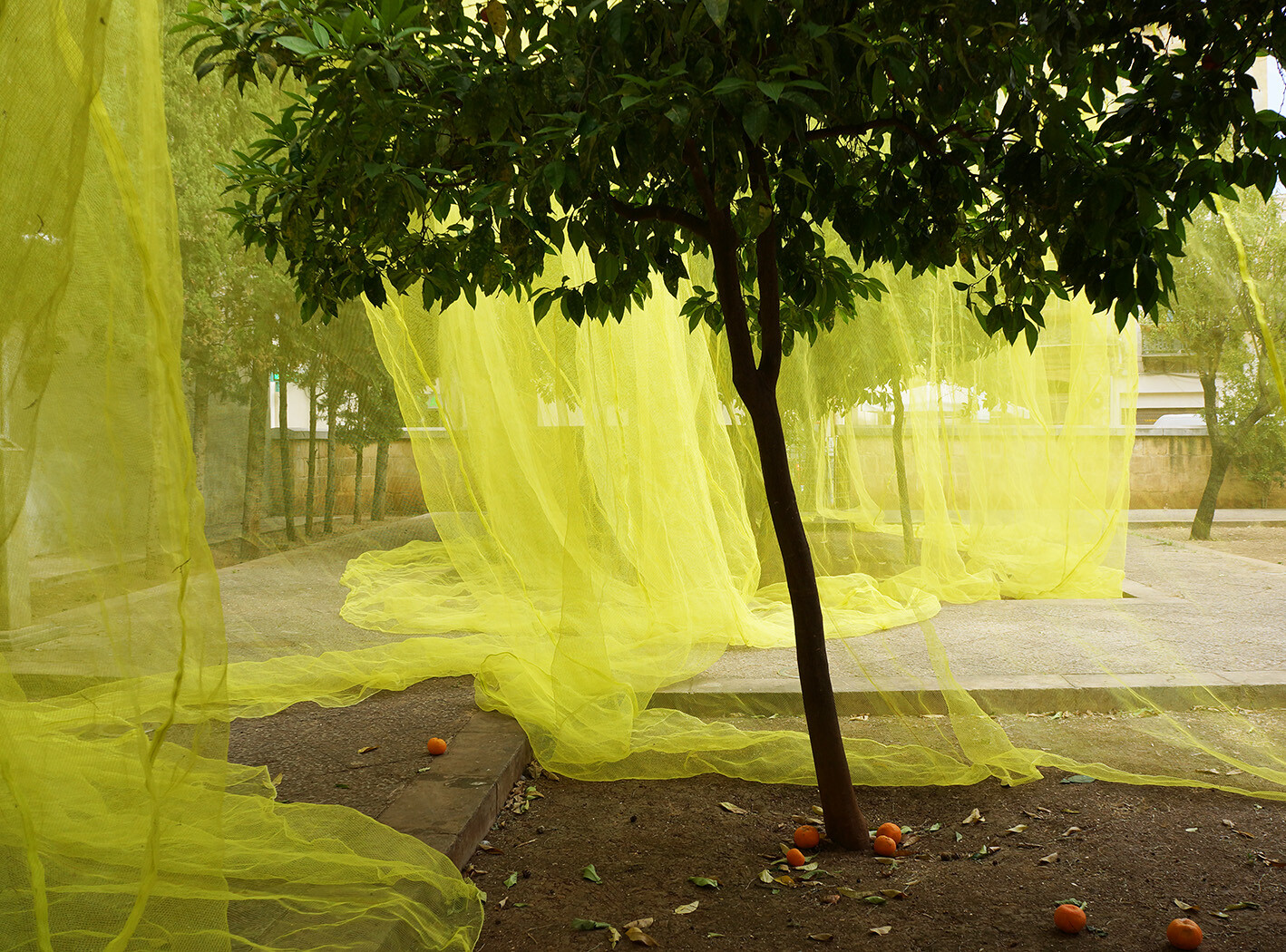
Cooking Sections, What is Above is What is Below, 2018. Installation at Manifesta 12, Giardino dei Giusti, Palermo.
Cooking Sections, What is Above is What is Below, 2018. Installation at Manifesta 12, Giardino dei Giusti, Palermo.
Formerly known as Giardino dell’Alloro, the Giardino dei Giusti had a monumental bay leaf tree until it was uprooted in 1704. Today, it is an open space in the inner part of the old city surrounded by the remains of walls bombed during World War II that emulates medieval xirbe—Arab-Norman productive gardens planted in neglected urban areas or among decaying ruins.37 Seven citrus trees grow inside. The new microclimate consists of color shade net enclosures patterned and sewn from readily available photo-selective agricultural netting, which is designed to influence biosynthesis, accelerate the ripening of the fruit through color wavelengths, and accumulate more phytochemicals.38 Choreographing and synchronizing neighbors in the surrounding buildings, the fluorescent yellow nets were suspended over the trees from a height of thirteen to fifteen meters from their balconies, creating a shaded and ventilated zone to reduce water stress for the trees inside.
In collaboration with agronomists Giuseppe Barbera, Antonio Motisi, and their team from the University of Palermo, devices were fabricated to monitor the live performance of the trees in these three new microclimates. They recorded the humidity, sunlight radiation, and temperature variations inside and outside the structures sheltering the trees from June to November of 2018. Data was made public online and in the city itself, alongside the installations.39
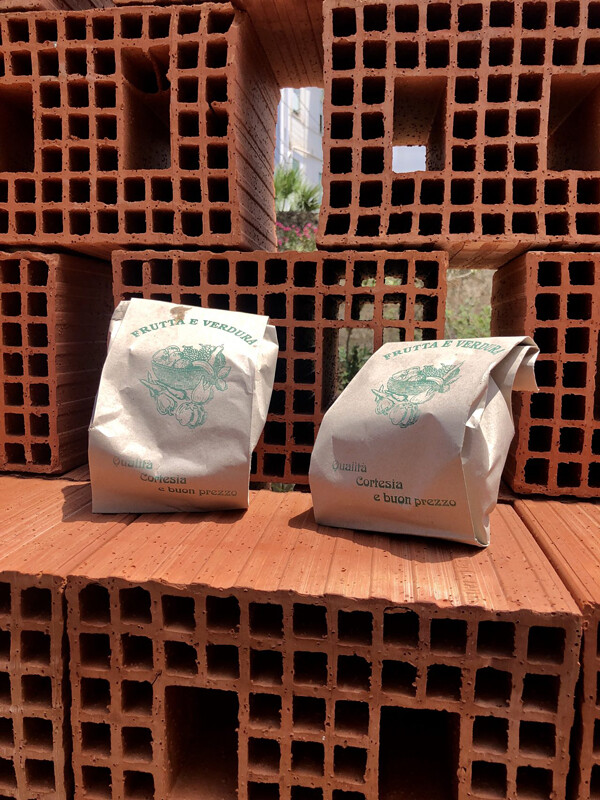

Cooking Sections, Secco al Sacco picnic box, 2018, part of the long-term project CLIMAVORE, 2015–ongoing. The project explores how to eat as climates change or as humans change climates. Offered by six restaurants throughout the duration of Manifesta 12, this take-away meal used drought-resistant ingredients that have adapted to grow with limited water in local arid landscapes or resist soil salinity. The drought dishes included ingredients such as: tumminia grain pasta (an ancient Sicilian cereal that has historically evolved to cope with water scarcity but fell in disuse against more “efficient” modern wheats); local varieties of capers, saffron, rosemary, almonds, sesame and small onions that require little or no irrigation; pomodoro siccagno (a Sicilian drought-resistant tomato variety); drinks made out of pomegranate and chinotto (a myrtle-leaved orange tree); prickly pear; moringa-based pizza; and mulberry ice-cream made with a base of carob flour. Photo: Monique Kawecki/Champ Magazine.
As contemporary versions of the Jardinu Pantescu, each microclimate valued different approaches to the reduction of water stress, engaging with the complexity of drought-resistant landscapes at architectural, agricultural, and sociological levels. Like food consumption habits, trees under water stress should prompt consideration of both individual and collective water footprints, and the economic implications of hydro-politics more broadly.40 To tackle the multiple causes of water overdependence, awareness of the multilayered ways that environments and climates are co-constructed is as crucial as water itself.
Italy is the largest producer of vegetables in Europe (19.8% of total harvest); Sicily is its largest agricultural region (10.8% of the agricultural area of the country), generating €4,335 million in harvest value annually. Eurostat, “Agricultural Census in Italy,” 2012, ➝.
Favara/fawarra (water spring); senia/saniya (water wheel); gebbia/gabiya (water tank); saja/saqiya (water channel). See Giuseppe Barbera, “Parchi, frutteti, giardini e orti nella Conca d’oro di Palermo araba e normanna,” Italus Hortus 14, no. 4 (2007): 14–27.
Pietro Laureano, The Water Atlas: Traditional Knowledge to Combat Desertification (Turin: Bollati Boringhieri, 2005). 24.
Juan García Latorre, Andrés Sánchez Picón, and Jesús García Latorre, “The Man-Made Desert: Effects of Economic and Demographic Growth on the Ecosystems of Arid Southeastern Spain,” in Environmental History 6, no. 1 (2001): 75–94, 82.
James C. Scott, Against the Grain: A Deep History of the Earliest States (New Haven and London: Yale University Press, 2017), 10–22.
Kolymbethra stands for “immersed” in Greek. The garden was also referred to as the Pool of the Gods.
Hypogean stands for “underground” from Greek hypó “under” and gaîa “earth.”
Note that the case of Palermo is particular as, contrary to other parts of Sicily, it is located on the Conca d’Oro (the Horn of Plenty), has considerably more underground water, and lies on a fertile plain instead of volcanic rock.
Giusy Lofrano, Maurizio Carotenuto, Roberta Maffettone, Pietro Todaro, Silvia Sammataro, and Ioannis K. Kalavrouziotis, “Water Collection and Distribution Systems in the Palermo Plain during the Middle Ages,” Water 5, no. 4 (2013): 1662-1676, ➝.
Sciroccato (affected by the sirocco wind) is a common Italian idiom to refer to someone whose behavior is confusing, dangerous, or nonsensical. Hence, it is a wind to be avoided as much as possible.
Simone Mantellini, “The Implications of Water Storage for Human Settlement in Mediterranean Waterless Islands: The Example of Pantelleria,” Association for Environmental Archaeology 20, no. 4 (2015): 406–424.
Francesco Brignone, I Giardini dell’Isola di Pantelleria (2012).
Giuseppe Barbera et al, “The ‘Jardinu’ of Pantelleria as a Paradigm of Resource-Efficient Horticulture in the Built-Up Environment,” Proceedings of the International Symposium on Greener Cities for More Efficient Ecosystem Services in a Climate Changing World (2018).
Simone Mantellini, “The Implications of Water Storage for Human Settlement in Mediterranean Waterless Islands: The Example of Pantelleria,” Association for Environmental Archaeology 20, no. 4 (2015): 406–424.
Interview with agronomist Graziella Pavia, Pantelleria February 18, 2018.
Giuseppe Barbera and Antonio Motisi, “Cultural Adaptation of Grapevine and Traditional Crops in a Unique Drystone Landscape: The Island of Pantelleria,” Paper presented at EASA2016: Anthropological Legacies and Human Futures Conference, July 21, 2016.
Ibid.
While the protected coastal plains around Palermo became one of the key sites for citrus groves through the introduction of intensive irrigation methods, the inner and western parts of the island were allocated for cereal production. As an interminable bread basket, first under Spanish colonial rule and later under the unified Italian nation, the Sicilian economy was eventually affected by the wheat boom in the U.S. in the 19th century. The subsequent local land struggles on the island around less globally competitive grain led to growing tensions among the population. Unsurprisingly, many decided to migrate; and apart from wheat and lemons, Sicily also started exporting its people. See Jane Schneider and Peter Schneider, Culture and Political Economy in Western Sicily (New York: Academic Press, 1976), ix.
Arcangelo Dimico, Alessia Isopi and Ola Olsson, “Origins of the Sicilian Mafia: The Market for Lemons,” Journal of Economic History 77, no. 4 (2017): 1083–1115.
Ibid.
Letter of the Commandant of Castellammare {sic} del Golfo to the Prince of Satriano, 23 September 1849. Cited in Ilaria Giglioli and Erik Swyngedouw, “Let’s Drink to the Great Thirst! Water and the Politics of Fractured Techno-natures in Sicily,” International Journal of Urban and Regional Research 32 (2008): 392–414.
Filippo Sabetti, Village Politics and the Mafia in Sicily (Montreal and Ithaca: McGill-Queen’s University Press, 2002), 59–60.
Ibid.
Clyde Haberman, “In Sicily, Even Water Has Its Price,” New York Times, July 22, 1989, ➝.
Umberto Santino, “Il ruolo della Mafia nel Saccheggio del Territorio,” in Casa Europa (Palermo: CSDGI, 2016). Ilaria Giglioli and Erik Swyngedouw, “Let’s Drink to the Great Thirst! Water and the Politics of Fractured Techno-natures in Sicily,” International Journal of Urban and Regional Research 32 (2008): 392–414.
Daron Acemoglu, Giuseppe De Feo, and Giacomo De Luca, “Weak States: Causes and Consequences of the Sicilian Mafia,” National Bureau of Economic Research Working Paper 24115, December 2017.
Giglioli and Swyngedouw, “Let’s Drink to the Great Thirst!”
Erik Swyngedouw, “Modernity and Hybridity: Nature, Regeneracionismo, and the Production of the Spanish Waterscape, 1890–1930,” Annals of the Association of American Geographers 89, no. 3 (1999): 443–465.
Marco Armiero, Filippo Gravagno, Giusy Pappalardo, and Alessia Denise Ferrara. “The Nature of Mafia: An Environmental History of the Simeto River Basin, Sicily,” Environment and History (2017).
According to the Agromafie Reports (reports about organized crimes connected to food supply chain published by the Italian Institute of Political, Economic and Social Studies) from 2011 to 2016. Armiero et al., “The Nature of Mafia.”
Crispian Balmer, “Italy’s Mafia Harvests Big Gains from Agriculture,” Reuters, February 17, 2016, ➝.
Letizia Palumbo and Alessandra Sciurba, “Vulnerability to Forced Labour and Trafficking: The case of Romanian women in the agricultural sector in Sicily,” Anti-Trafficking Review 5 (2015).
Adam Vaughan, “Climate Change Rate to Turn Southern Spain to Desert by 2100, Report Warns,” The Guardian, October 26, 2016, ➝. See also Eyal Weizman, Erasure: The Conflict Shoreline (Göttingen: Steidl, 2014), 25.
Jacob Bunge, “A Warming Climate Brings New Crops to Frigid Zones,” Wall Street Journal, November 25, 2018, ➝.
Since the 1999 adoption of the Tampere Council Conclusions, the EU’s first milestone toward a common strategy aimed at the recovery of the proceeds of crime, Sicily has 2,088 confiscated and reactivated assets. But on the basis of the emotional wave of terror sparked by the period of Mafia massacres in Sicily, a cultural and social rebellion against eco-mafia activities pushed institutional efforts to emerge from a grassroots level in the late 1990s and early 2000s: citizens, associations, and various political and religious networks became aware that it was not possible to delegate efforts against the proliferation of Mafia only to the judiciary or law enforcement. See Michele Maria Anzalone, “The Up-Cycle Beyond the Crime: The Productive Re-Activation of Confiscated Criminal Assets,” PhD dissertation, submitted 2017, Universitá degli Studi di Palermo School of Architecture. See also EUR-Lex, Directive 2014/42/EU, “Freezing and Confiscation of Proceeds of Crime,” Art. 3.
Barbera, “Parchi, frutteti, giardini e orti.”
Zoran S. Ilić, Lidija Milenković, Ljubomir Šunić, and Maja Manojlović, “Color Shade Nets Improve Vegetables Quality at Harvest and Maintain Quality During Storage,” Contemporary Agriculture 67, no 1. (2018): 9–19.
See ➝.
See Tony Allen, Virtual Water: Tackling the Threat to Our Planet’s Most Precious Resource (London: I.B. Tauris, 2011); and Arjen Y. Hoekstra, “Human Appropriation of Natural Capital: A Comparison of Ecological Footprint and Water Footprint Analysis,” Ecological Economics 68, no. 7 (2009): 1963–1974.
Liquid Utility is a collaboration between e-flux Architecture and the Temple Hoyne Buell Center for the Study of American Architecture at Columbia University as part of their project “Power: Infrastructure in America.”
